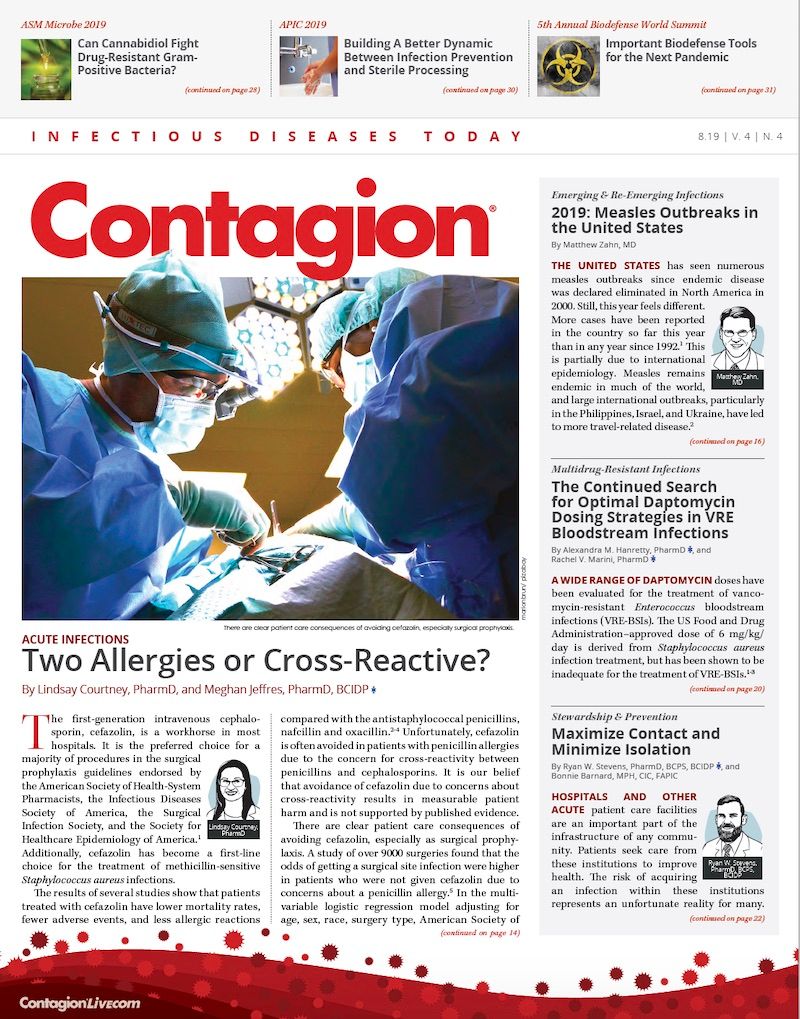Postulates About the Prostate: Fosfomycin for Chronic Bacterial Prostatitis
Fosfomycin is an attractive potential option because it does not cross-react with other antimicrobials, making it a good choice in patients with extensive drug allergies.
Prostatitis is the inflammation and infection of the prostate. The bacterial pathogens involved are similar to those involved in other urologic infections. Although Escherichia coli is the most common causative pathogen, other etiologies include Pseudomonas aeruginosa, Klebsiella spp., Enterococcus spp., Enterobacter spp., Proteus spp., and Serratia spp. In sexually active men, Neisseria gonorrhoeae and Chlamydia trachomatis should also be consid­ered.1 Treatment of prostatitis can be difficult, as many antimicrobials cannot penetrate into the prostate. Current oral treatment options include fluoroquinolones, tetracyclines, and sulfame­thoxazole/trimethoprim. However, adverse reac­tions and increasing resistance against these antimicrobials warrant alternative options for oral therapy.
Fosfomycin is an attractive potential option because it does not cross-react with other antimicrobials, making it a good choice in patients with extensive drug allergies. It retains activity against many of the impli­cated organisms, including multidrug-resistant strains such as extended-spectrum beta-lact­amase (ESBL)-producing Enterobacteriales and vancomycin-resistant enterococci. It is also available in an oral dosage form. However, aside from a few case reports, there are limited data regarding the dosing, duration, and efficacy of fosfomycin for the treatment of prostatitis.2,3
Karaiskos and colleagues conducted a prospective observation study that set out to identify the effectiveness and safety of oral fosfomycin in the treatment of chronic pros­tatitis.⁴ Patients were enrolled if they had more than 3 months of symptoms consis­tent with prostatitis, positive urine/prostatic secretion cultures, a negative polymerase chain reaction for sexually transmitted infections, imaging suggesting prostatic inflammation and did not have other orally available antimicrobial options (eg, were resistant, had allergies or adverse reactions). Patients provided consent to participate. Fosfomycin was dosed at 3 g orally daily for 1 week, then 3 g orally every 48 hours for the remainder of therapy. Patients were treated for either 6 weeks or 12 weeks, if they had evidence of prostatic calcifica­tions. Minimum inhibitory concentrations (MICs) were evaluated via Etest (bioMérieux). Primary outcomes included cure at end of therapy, defined as resolution or improve­ment of all signs of infection, and relapse rates, defined as isolation of the same caus­ative pathogen during treatment or follow-up, at 3 and 6 months of follow-up.
Forty-four male patients were enrolled, ranging in age from 28 to 82 years (median 54). Most patients had experienced 2 episodes of chronic bacterial prostatitis. E coli was the most common causative pathogen (66%), followed by Klebsiella (14%), and Enterococcus faecalis (14%). Most isolates were multi­drug-resistant (59%), with 23% displaying evidence of ESBL. The median fosfomycin MIC was 1.5 mcg/ mL (range, 0.125-32 mcg/ mL) for gram-negatives and 8 mcg/mL (range 4-24 mcg/ mL) for E faecalis.
Cure was achieved in 82% (36/44 patients) of participants at end of therapy, with a similar breakdown between the 6- and 12-week groups (Table). Cure at the 3- and 6-month follow-ups were 80% and 73%, respectively. Fosfomycin resistance emerged in 5 patients, 2 were in the 6-week group and 3 in the 12-week group. Overall, fosfo­mycin was well tolerated. Eight patients (18%) reported diarrhea, which resolved in 4 patients by extending the dosing interval from every 48 hours to every 72 hours. One patient discontinued treatment due to diarrhea. No patients tested positive for Clostridioides difficile.
Although this was a small, single-center study with no comparator arm, the results provide valuable insight into the treatment of chronic bacterial prostatitis. This is the largest study to date of oral fosfomycin for this condition, with positive results. A more concrete dosing regimen was used, and the study provided long-term tolerability infor­mation. Additionally, a significant number of patients presented with resistant organisms.
In an era of increasing antimicrobial resis­tance, the only option for many patients may be intravenous therapy. Furthermore, many patients may not tolerate the available oral options that can penetrate the prostate. The fluoroquinolones, which have long been considered the gold standard of prostatitis treatment, carry several concerning adverse effects. Additionally, fluoroquinolones, sulfame­thoxazole/trimethoprim, and tetracyclines can interact with many other medications.
This study’s results provide the proof-of-con­cept for a larger randomized controlled trial of fosfomycin in the treatment of prostatitis. In the meantime, this study may be used to support initiating fosfomycin in a patient with contraindications to one of the available oral alternatives for prostatitis.
Monica V. Mahoney, PharmD, BCPS AQ-ID, BCIDP is a clinical pharmacy specialist at Beth Israel Deaconess Medical Center. Her practice site is in the ID outpatient and OPAT clinics in Boston, MA.
*Mahoney is a member of the Society of Infectious Disease Pharmacists.
References:
- Coker TJ, Dierfeldt DM. Acute bacterial prostatitis: diagnosis and management. Am Fam Physician. 2016;93(2):114-120.
- Grayson ML, Macesic N, Trevillyan J, et al. Fosfomycin for treatment of prostatitis: new tricks for old drugs. Clin Infect Dis. 2015;61(7):1141-1143. doi: 10.1093/cid/civ436.
- Zhanel GG, Zhanel MA, Karlowsky JA. Oral fosfomycin for the treatment of acute and chronic bacterial prostatitis caused by multidrug-resistant Escherichia coli. Can J Infect Dis Med Microbiol. 2018;2018:1404813. doi: 10.1155/2018/1404813.
- Karaiskos I,Galani L, Sakka V, et al. Oral fosfomycin for the treatment of chronic bacterial prostatitis [printed online February 22, 2019]. J Antimicrob Chemother. doi: 10.1093/jac/dkz015.

